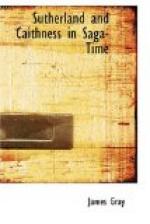Of the next nine centuries from 1000 to the present time it is proposed to deal with the first two hundred and seventy years only, which, with the preceding century and a half, form a chapter of Scottish history complete in itself. The narrative, as already stated, will be based largely upon the great Stories or Tales known as the Orkneyinga, St. Magnus’, and Hakonar Sagas, and also upon Scottish and English chronicles and records so far as they throw their fitful light upon the northern counties of Scotland, and especially upon Caithness and Sutherland, during the dark periods between these Sagas.
Attention will have to be paid to the Pictish family of Moldan of Duncansby, of Moddan, created Earl of Caithness by his uncle Duncan I, and of Moddan “in Dale,” each of whom in turn succeeded to much of the estates of the ancient Maormors of Duncansby, but whose people had been driven back from most of the best low-lying lands into the upper valleys and the hills by the foreign invaders of Cat. For, when the Norse Vikings first attacked Cat and succeeded in conquering the Picts there, they conquered by no means the whole of that province. They subdued and held only that part of Ness or modern Caithness which lies next its north and east coasts, and the rest of the sea-board of Ness, Strathnavern and Sudrland, forcing their way up the lower parts of the valleys of these districts, as their place-names still live on to prove; but they never conquered, so as to occupy and hold them, the upper parts of these river basins or the hills above them, which remained in possession of Picts and Gaels throughout the whole period of the Norse occupation. Further, the Picts and Gaels extended the area which they retained, until Norse rule was expelled from the mainland altogether.
In Strathnavern and in the upper valleys of its rivers, and also in Caithness in the uplands of the river Thurso, and in a large part of Sudrland the Pictish family and clan of Moddan in its various branches subsisted all through the Norse occupation, and it is hoped to show good reason for believing that the family of Moddan, with the Pictish or Scottish family of Freskyn de Moravia in later times, was the mainstay of Scottish rule in the extreme north until the shadowy claims of Norse suzerains over every part of the mainland were completely repelled, and avowedly abandoned.




